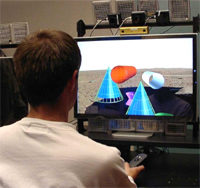Personal Varrier: Autostereoscopic Virtual Reality for Distributed Scientific Visualization
October 1st, 2006
Categories: Devices, Visualization, VR

Authors
Peterka, T., D. Sandin, D., Ge, J., Girado, J., Kooima, R., Leigh, J., Johnson, A., Thiebaux, M., DeFanti, T.About
As scientific data sets increase in size, dimensionality, and complexity, new high resolution, interactive, collaborative networked display systems are required to view them in real-time. Increasingly, the principles of virtual reality (VR) are being applied to modern scientific visualization. One of the tenets of VR is stereoscopic (stereo or 3D) display, however the need to wear stereo glasses or other gear to experience the virtual world is encumbering and hinders other positive aspects of VR such as collaboration.
Autostereoscopic (autostereo) displays present imagery in 3D without the need to wear glasses or other gear, but few qualify as VR displays. The Electronic Visualization Laboratory (EVL) at the University of Illinois at Chicago (UIC) has designed and built a single-screen version of its 35-panel tiled Varrier™ display, called Personal Varrier. Based on a static parallax barrier and the Varrier computational method, Personal Varrier provides a quality 3D autostereo experience in an economical, compact form factor.
The system debuted at iGrid 2005 in San Diego, CA, accompanied by a suite of distributed and local scientific visualization and 3D teleconferencing applications. The CAVEwave National LambdaRail (NLR) network was vital to the success of the stereo teleconferencing.
Keywords: Varrier, Personal Varrier, virtual reality, autostereoscopy, autostereo, 3D display, camera-based tracking, parallax barrier
Resources
Citation
Peterka, T., D. Sandin, D., Ge, J., Girado, J., Kooima, R., Leigh, J., Johnson, A., Thiebaux, M., DeFanti, T., Personal Varrier: Autostereoscopic Virtual Reality for Distributed Scientific Visualization, Future Generation Computing Systems, vol 22, no 8, pp. 976-983, October 1st, 2006.